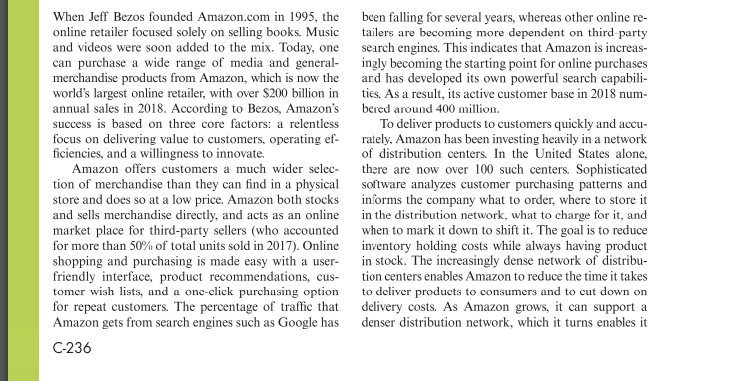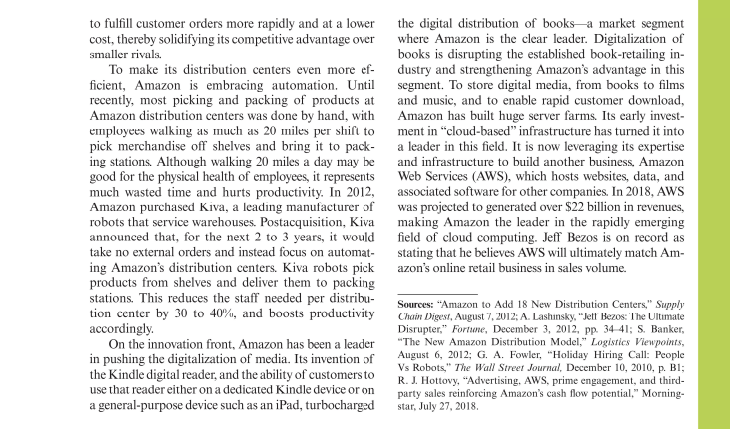Answered step by step
Verified Expert Solution
Question
1 Approved Answer
Use the case study to answer the question below. What resources/capabilities does Amazon have that enables it to achieve sustainable competitive advantage? In what value
Use the case study to answer the question below.


What resources/capabilities does Amazon have that enables it to achieve sustainable competitive advantage? In what value chain activity (or activities) are these resources located?
When Jeff Bezos founded Amazon.com in 1995, the online retailer focused solely on selling books. Music and videos were soon added to the mix. Today, one can purchase a wide range of media and generalmerchandise products from Amazon, which is now the world's largest online retailer, with over $200 billion in annual sales in 2018. According to Bezos, Amazon's success is based on three core factors: a relentless focus on delivering value to customers, operating efficiencies, and a willingness to innovate. Amazon offers customers a much wider selection of merchandise than they can find in a physical store and does so at a low price. Amazon both stocks and sells merchandise directly, and acts as an online market place for third-party sellers (who accounted for more than 50% of total units sold in 2017). Online shopping and purchasing is made easy with a userfriendly interface, product recommendations, customer wish lists, and a one-click purchasing option for repeat customers. The percentage of traffic that Amazon gets from search engines such as Google has been falling for several years, whereas other online retailers are becoming more dependent on third-party search engines. This indicates that Amazon is increasingly becoming the starting point for online purchases and has developed its own powerful search capabilities. As a result, its active customer base in 2018 numbered around 400 million. To deliver products to customers quickly and accurately. Amazon has been investing heavily in a network of distribution centers In the United States alone, there are now over 100 such centers. Sophisticated software analyzes customer purchasing patterns and informs the company what to order, where to store it in the distribution network, what to charge for it, and when to mark it down to shift it. The goal is to reduce inventory holding costs while always having product in stock. The increasingly dense network of distribution centers enables Amazon to reduce the time it takes to deliver products to consumers and to cut down on delivery costs. As Amazon grows, it can support a denser distribution network, which it turns enables it C-236 to fulfill customer orders more rapidly and at a lower cost, thereby solidifying its competitive advantage over smaller rivals. To make its distribution centers even more efficient, Amazon is embracing automation. Until recently, most picking and packing of products at Amazon distribution centers was done by hand, with employees walking as much as 20 miles per shift to pick merchandise off shelves and bring it to packing stations. Although walking 20 miles a day may be good for the physical health of employees, it represents much wasted time and hurts productivity. In 2012, Amazon purchased Kiva, a leading manufacturer of robots that service warehouses. Postacquisition, Kiva announced that, for the next 2 to 3 years, it would take no external orders and instead focus on automating Amazon's distribution centers. Kiva robots pick products from shelves and deliver them to packing stations. This reduces the staff needed per distribution center by 30 to 40%, and boosts productivity accordingly. On the innovation front. Amazon has been a leader in pushing the digitalization of media. Its invention of the Kindle digital reader, and the ability of customers to use that reader either on a dedicated Kindle device or on a general-purpose device such as an iPad, turbocharged the digital distribution of books - a market segment where Amazon is the clear leader. Digitalization of books is disrupting the established book-retailing industry and strengthening Amazon's advantage in this segment. To store digital media, from books to films and music, and to enable rapid customer download, Amazon has built huge server farms. Its early investment in "cloud-based" infrastructure has turned it into a leader in this field. It is now leveraging its expertise and infrastructure to build another business. Amazon Web Services (AWS), which hosts websites, data, and associated software for other companies. In 2018, AWS was projected to generated over $22 billion in revenues, making Amazon the leader in the rapidly emerging field of cloud computing. Jeff Bezos is on record as stating that he believes AWS will ultimately match Amazon's online retail business in sales volume. Sources: "Amazon to Add 18 New Distribution Centers," Supply Chain Digesf, August 7, 2012; A. Lashmsky, "Jetl Bezos: I he Ultmate Disrupter," Fornone, December 3, 2012, pp. 34-41; S. Banker, "The New Amazon Distribution Model," Logistics Vlewpoints, August 6, 2012; G. A. Fowler, "Holiday Hiring Call: People Vs Robots," The Wall Street Journal, December 10, 2010, p. B1; R. J. Hottovy, "Advertising, AWS, prime engagement, and thirdparty sales reinforcing Amazon's cash flow potential," Morningstar, July 27,2018Step by Step Solution
There are 3 Steps involved in it
Step: 1

Get Instant Access to Expert-Tailored Solutions
See step-by-step solutions with expert insights and AI powered tools for academic success
Step: 2

Step: 3

Ace Your Homework with AI
Get the answers you need in no time with our AI-driven, step-by-step assistance
Get Started


